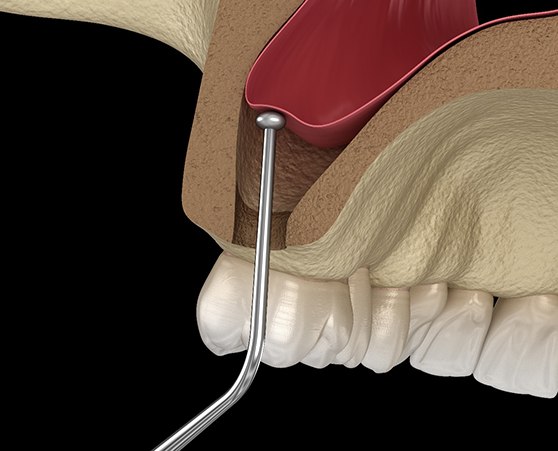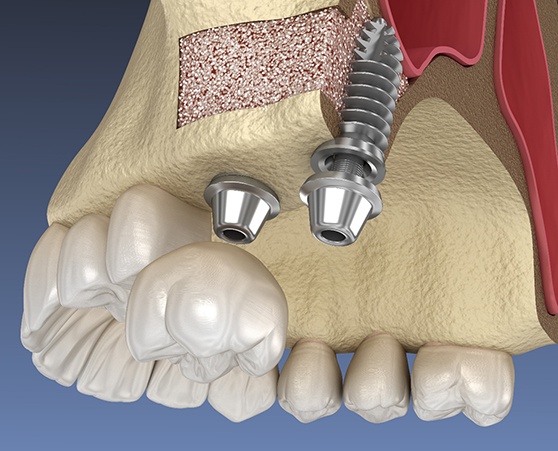Sinus Lift – Coppell, TX
Preparing Your Upper Jaw for Dental Implants
While dental implants are an attractive option for replacing any number of missing teeth, some patients are only able to have them placed after certain preparatory procedures have been completed. As an example, if you want to get dental implants to replace your upper molars, you may need to undergo a type of oral surgery known as a sinus lift. Dr. Steele will be happy to explain the specifics of this procedure and how it can set you up for dental implant success. Feel free to call us today if you would like more information about sinus lifts.
Why Choose Steele Dental for Sinus Lifts?
- Experienced, Gentle Oral Surgeon
- State-of-the-Art Technology
- Team That’s Mindful of Your Time
What Is a Sinus Lift?

A sinus lift can be thought of as a type of bone graft that specifically involves the upper jawbone. Like a regular bone graft, it involves applying grafting material in an area where bone density is lacking. However, it also involves another step: moving the sinus cavity upward.
At the beginning of a sinus lift procedure, your mouth will be numbed with a local anesthetic. Then small incisions will be made in the gum tissue, and an opening will be created in the jawbone. Said opening will allow us to carefully lift the membrane of the sinus; this creates an empty space where the grafting material can be placed.
Once a sinus lift is complete, the gums will be sutured shut so that they can heal. It can take four to nine months for the grafting material to fully integrate with the rest of your jaw; once this process is complete, you can move forward with dental implant surgery.
Indications for Sinus Lifts

It’s important to note that not everyone will need to have a sinus lift performed in order to become eligible for dental implants. Our team can carefully examine your jaw to determine what treatments may or may not be necessary to help you rebuild your smile. A sinus lift may be required if:
- There simply isn’t enough bone in your upper jaw for dental implants.
- A significant amount of bone tissue in the upper jaw has been lost as a consequence of gum disease.
- Bone resorption has taken place due to tooth loss.
- Your sinus cavity is too close to the area where your dental implants need to be inserted.
Purpose of a Sinus Lift

Ultimately, a sinus lift has two purposes. First, it helps ensure that your dental implants can be placed without damaging your sinus cavity. Second, it ensures that there’s an adequate amount of bone tissue for the implant post to join with. By having a sinus lift performed, you can significantly increase your odds of a successful dental implant procedure, allowing you to fully enjoy the benefits of new teeth supported by reliable artificial roots.
Sinus Lift FAQs
What would happen if I don’t get a sinus lift?
If you are a good candidate for a sinus lift, but you choose not to get it and still have dental implants placed, a few things might happen. Firstly, the implant will likely not have enough bone to keep it in place, meaning it will be unstable and potentially fall out. Also, there is a chance the implant would press into or even penetrate the sinus membrane because of how thin the upper jaw is. As you can imagine, none of these outcomes feel great, which is why it’s always in your best interest to get a sinus lift if suggested. Otherwise, it’s simply too risky to get dental implants because of the increased chance of complications.
Does getting a sinus lift hurt?
Not when Dr. Steele does it! Throughout his education, training, and decades-long career, he has developed a light touch and minimally invasive technique, meaning that you shouldn’t feel much of anything while in the chair. You will probably be a bit sore and develop some swelling afterward, but these symptoms are expected, minor, and brief. Just taking OTC pain medication is all that most patients need to remain comfortable during the initial recovery period.
Will a sinus lift affect my sinuses?
A sinus lift should not affect your sinuses in any perceptible way when it comes to your breathing or allergies. One of the big goals of this procedure is to protect the health and integrity of your sinus membrane, so you won’t notice a difference following the treatment.
Can I use dental insurance to help pay for a sinus lift?
Many dental insurance plans offer at least partial coverage for oral surgery procedures like a sinus lift (assuming you’ve met your deductible and haven’t exceeded your annual maximum). We can’t confirm whether or not you could use your plan to help pay for this treatment without speaking to you first and going over your benefits. Be sure to read over your policy, and if you have any questions about what you might be expected to pay out of pocket, just reach out to our team, and we’ll be happy to clarify things for you.






